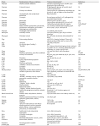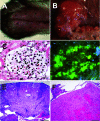A One Health Perspective for Defining and Deciphering Escherichia coli Pathogenic Potential in Multiple Hosts
- PMID: 33419487
- PMCID: PMC7898170
- DOI: 10.30802/AALAS-CM-20-000054
A One Health Perspective for Defining and Deciphering Escherichia coli Pathogenic Potential in Multiple Hosts
Abstract
E. coli is one of the most common species of bacteria colonizing humans and animals. The singularity of E. coli 's genus and species underestimates its multifaceted nature, which is represented by different strains, each with different combinations of distinct virulence factors. In fact, several E. coli pathotypes, or hybrid strains, may be associated with both subclinical infection and a range of clinical conditions, including enteric, urinary, and systemic infections. E. coli may also express DNA-damaging toxins that could impact cancer development. This review summarizes the different E. coli pathotypes in the context of their history, hosts, clinical signs, epidemiology, and control. The pathotypic characterization of E. coli in the context of disease in different animals, including humans, provides comparative and One Health perspectives that will guide future clinical and research investigations of E. coli infections.
Figures













Similar articles
-
Characterization of the contribution to virulence of three large plasmids of avian pathogenic Escherichia coli chi7122 (O78:K80:H9).Infect Immun. 2010 Apr;78(4):1528-41. doi: 10.1128/IAI.00981-09. Epub 2010 Jan 19. Infect Immun. 2010. PMID: 20086082 Free PMC article.
-
Molecular characterization of enterohemorrhagic Escherichia coli hemolysin gene (EHEC-hlyA)-harboring isolates from cattle reveals a diverse origin and hybrid diarrheagenic strains.Infect Genet Evol. 2016 Apr;39:342-348. doi: 10.1016/j.meegid.2016.02.002. Epub 2016 Feb 22. Infect Genet Evol. 2016. PMID: 26855346
-
High frequency of hybrid Escherichia coli strains with combined Intestinal Pathogenic Escherichia coli (IPEC) and Extraintestinal Pathogenic Escherichia coli (ExPEC) virulence factors isolated from human faecal samples.BMC Infect Dis. 2018 Nov 1;18(1):544. doi: 10.1186/s12879-018-3449-2. BMC Infect Dis. 2018. PMID: 30497396 Free PMC article.
-
Diversity of Hybrid- and Hetero-Pathogenic Escherichia coli and Their Potential Implication in More Severe Diseases.Front Cell Infect Microbiol. 2020 Jul 15;10:339. doi: 10.3389/fcimb.2020.00339. eCollection 2020. Front Cell Infect Microbiol. 2020. PMID: 32766163 Free PMC article. Review.
-
Escherichia coli mediated urinary tract infections: are there distinct uropathogenic E. coli (UPEC) pathotypes?FEMS Microbiol Lett. 2005 Nov 15;252(2):183-90. doi: 10.1016/j.femsle.2005.08.028. Epub 2005 Sep 6. FEMS Microbiol Lett. 2005. PMID: 16165319 Review.
Cited by
-
Trends in the Prevalence of Antimicrobial Resistance in Escherichia coli Isolated from Outpatient Urine Cultures in French Amazonia.Am J Trop Med Hyg. 2024 Jun 25;111(2):287-296. doi: 10.4269/ajtmh.23-0887. Print 2024 Aug 7. Am J Trop Med Hyg. 2024. PMID: 38917783 Free PMC article.
-
Polyclonal carbapenemase-producing Escherichia coli in Northern Italy: the emergence of NDM-7.Front Cell Infect Microbiol. 2025 Mar 14;15:1519827. doi: 10.3389/fcimb.2025.1519827. eCollection 2025. Front Cell Infect Microbiol. 2025. PMID: 40160473 Free PMC article.
-
Virulence Profiles and Antibiotic Susceptibility of Escherichia coli Strains from Pet Reptiles.Pathogens. 2022 Jan 21;11(2):127. doi: 10.3390/pathogens11020127. Pathogens. 2022. PMID: 35215071 Free PMC article.
-
Prevalent and Drug-Resistant Phenotypes and Genotypes of Escherichia coli Isolated from Healthy Cow's Milk of Large-Scale Dairy Farms in China.Int J Mol Sci. 2025 Jan 8;26(2):454. doi: 10.3390/ijms26020454. Int J Mol Sci. 2025. PMID: 39859170 Free PMC article.
-
A Comprehensive Review of the Role of Virulence Factors in Enteropathogenic Escherichia coli-Induced Intestinal Injury.Cureus. 2025 May 4;17(5):e83475. doi: 10.7759/cureus.83475. eCollection 2025 May. Cureus. 2025. PMID: 40470429 Free PMC article. Review.
References
-
- Abaas S, Franklin A, Kuhn I, Orskov F, Orskov I. 1989. Cytotoxin activity on Vero cells among Escherichia coli strains associated with diarrhea in cats. Am J Vet Res 50:1294–1296. - PubMed
Publication types
MeSH terms
Substances
LinkOut - more resources
Full Text Sources
Other Literature Sources
Medical
Molecular Biology Databases

